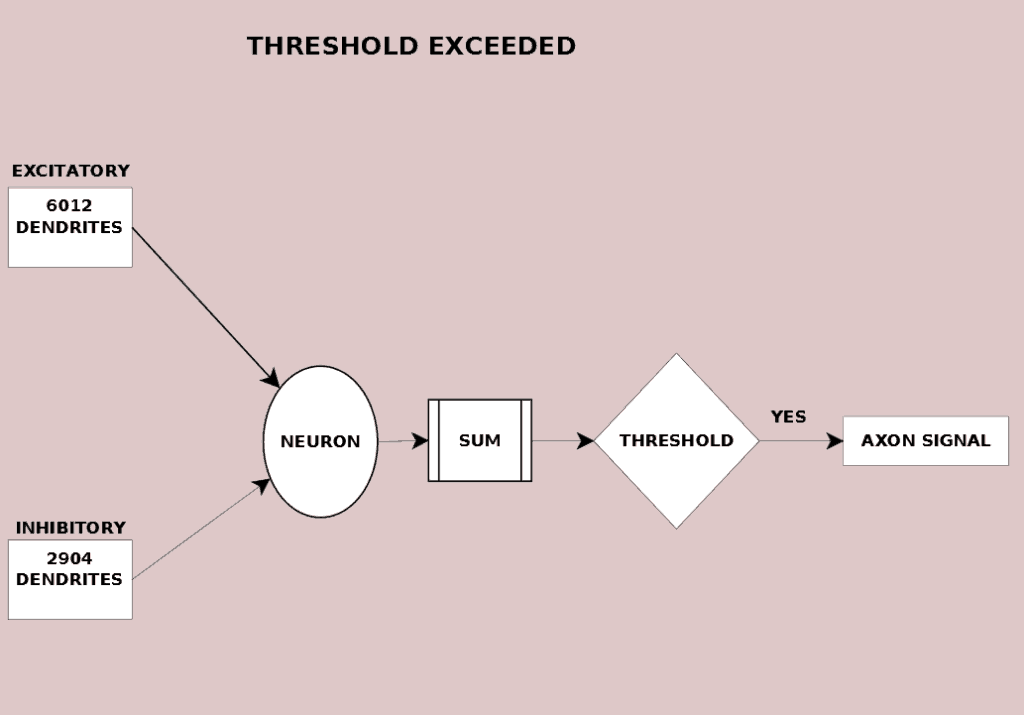Talking with the StressDoc, Mark Gorkin, about Partial Pattern Completed. Evidence, he asked—how close does a partial pattern have to be for a gestalt completion to occur?
I had to admit I couldn’t answer that. There are probably some clues in the length of sensory duration, as in vision with the phi phenomena and movies, but I couldn’t find indicators that discussed the closest needed.
Fidelity at Almost Gate

I did mention that the measure of fidelity maintained across the Almost Gate (Figure 1) is a worthy candidate, but the facts to drive the calculation are beyond current information.
The Almost Gate triggers the same response—treats two dissimilar inputs as identical—if they both cause the neural threshold to be exceeded. A few preliminary notes before we consider the relationship that must be satisfied for a neuron to be fired.
- There are 7 thousand dendritic inputs, on the average, to a neuron which are excitatory. This is a genetic endowment.
- There are 3 thousand,dendritic inputs, on the average, to a neuron which are inhibitory. This is a genetic endowment.
- Each of these 10 thousand inputs have a unique synaptic efficiency. These are the result of experiences.
- Neural (Almost Gate) threshold ≈ 65 mV (milliVolts)
- fMRI (functional Magnetic Resonance Imaging), currently our most precise tool, has an acuity of perhaps 1 million brain cells in a voxel (visual volume element). From fMRI we are not getting a measurement of individual neurons.
If the sum of all the excitatory inputs that send in signals multiplied by their respective synaptic efficiencies minus the sum of all inhibitory inputs firing times their respective synaptic efficiencies exceeds the threshold of that neuron, then the distinction between the two dissimilar inputs is indistinguishable. Figure 2 presents the raw equation.
Fidelity could be calculated as the number of combinations of excitatory and inhibitory inputs that make the inequality true divided by the total number of combinations possible.
Obviously this is an open and interesting question.
More: Neural Threshold


Fidelity between two inputs measured by overlap of two sets of firing dendrites divided by the total number of firing elements of the first input.
Consider this concrete, but artificial numbers
Set a. 6012 excitatory dendrites and 2904 inhibitory dendrites deliver non-zero inputs which causes the neuron to fire.
Set b. 6016 excitatory dendrites and 2907 inhibitory dendrites deliver non-zero inputs which causes the neuron to fire.
The intersection of a and b is 5900 excitatory and 2800 inhibitory dendrites.
Fidelity=(firing_a ∩ firing_b ) /firing_a
Fidelity=8700/8916
Fidelity=97.6%
A question came up in Quora that this post supplies necessary background information. The question and my answer: What is the difference between our brain and our mind? (https://www.quora.com/What-is-the-difference-between-our-brain-and-our-mind-At-what-point-does-that-change-happen/answer/Robert-Hamill-3)
Summarisation of detailed answer: “The mind arises from subjective assessment of external reality by the neural operations of the brain.”